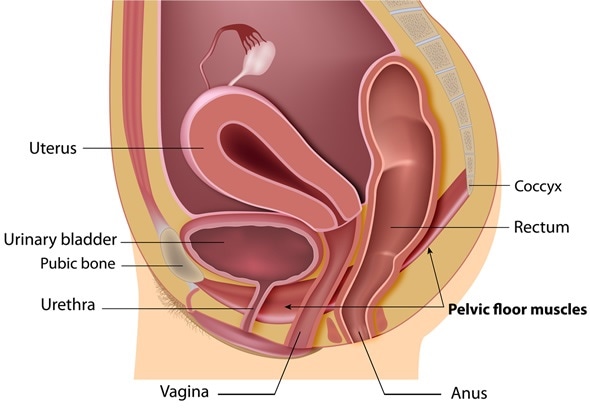For The Latest Medical News, Health News, Research News, COVID-19 News, Pharma News, Glaucoma News, Diabetes News, Herb News, Phytochemical News, Thailand Cannabis News, Cancer News, Doctor News, Thailand Hospital News, Oral Cancer News, Thailand Doctors
The pelvic floor is a thin but strong sheet of muscle and connective tissue that closes off the pelvic cavity from below. It supports the pelvic organs, which include the urinary bladder, the uterus, cervix and vagina, and the last part of the large bowel (the rectum) in women. In men, it contains the bladder and the rectum.
The muscles that make up the pelvic floor are the levator ani and the coccygeus muscles that pair together to seal off the pelvic cavity, forming the pelvic diaphragm. The levator ani consists of two parts, the inner pubococcygeus muscle and the outer iliococcygeusmuscle, both attached to the sacrum at the back but starting from the pubic bones and the ilial bones, respectively, in front.
These muscles form a wide sling like a hammock, starting from all around the fan-shaped pelvic bone and connecting to the pelvic organs through firmly wrapped circular muscle fibers and thickenings of the fibrous tissue that envelops it.
The pubococcygeus muscles pass backwards leaving a gap in the middle, which is where the passages for the pelvic organs are located. This is the urogenital hiatus. The rest of the levator ani is formed by the thinner iliococcygeus. Its fibers join behind the anus to form a plate of strong connective tissue called the levator plate, which supports the pelvic organs at rest.
The pelvic floor has two openings for each of the passages to the outside, the urogenital hiatus and the rectal hiatus. In women, the vagina and the urethra pass through the urogenitcal hiatus and the rectum passes through the rectal hiatus. In men, the urethra passes through the urogenital hiatus and the rectum through the rectal hiatus.

The pelvic muscles form circular sphincters to control the passage of substances through each of these passages, namely, the urethral sphincter and the anal sphincter. Thus continence is an important function of the pelvic floor.
These muscles are responsible for giving you control over urination, defecation, and flatulence. They also are involved in orgasms. They hold up the pelvic organs against gravity, keeping them in position during moments of increased abdominal pressure, as when you sneeze orcough or laugh. When the bladder tightens to force urine out, there is a coordinated relaxation of the part of the muscle that circles around the urethra to allow the urine to flow outside. Similar relaxation occurs during defecation, childbirth and vaginal intercourse.
When the pelvic floor contracts, the organs it supports are lifted higher, and the passages are squeezed shut. When it relaxes, on the other hand, the muscular sheet descends and the orifices are opened.
The importance of this muscular sheet is immense. It forms part of the core muscles, a group of voluntary muscles which are responsible for maintaining posture, abdominal organ position and intra-abdominal pressure. They work together with the deep abdominal muscles and the back muscles to keep the body straight without fatigue. In the ideal situation, the changes in the pressure inside the abdomen that happen, for instance, during a cough, sneeze or lifting something heavy, are automatically regulated between the abdominal, back and pelvic floor muscles. As the pressure rises, they contract to support the spine and the abdominal organs from being displaced, and the body performs the action smoothly.
However, weakening of the core muscles leads to alteration of this rhythm. For instance, when the pelvic floor muscles are damaged, increases in intra-abdominal pressure push down the weak pelvic floor, causing the pelvic organs to descend lower. If this lasts a long time, the pelvic organs permanently change their position, which is called pelvic organ prolapse. Symptoms of this may range from stress incontinence to actual descent of the uterus through the vaginal opening.
The pelvic floor itself is not visible from the outside, but it can be trained by conscious exercise. When the levator plate is weak, the pelvic organs sag and may slip through the enlarged urogenital hiatus.